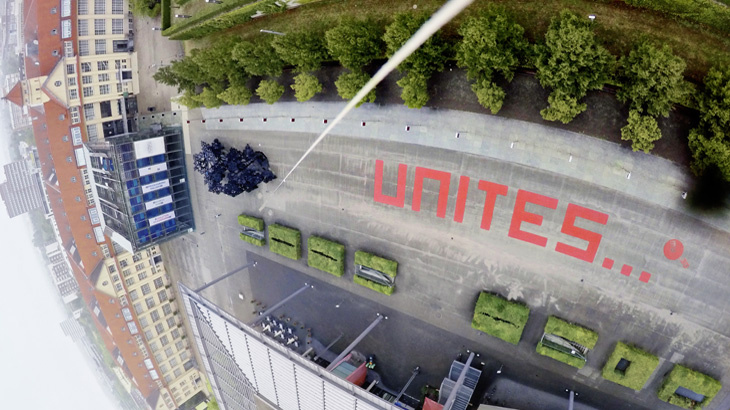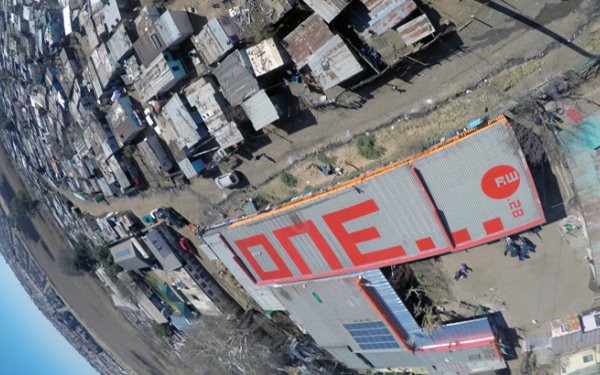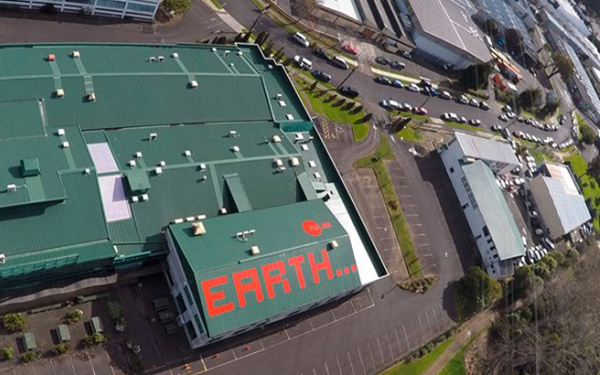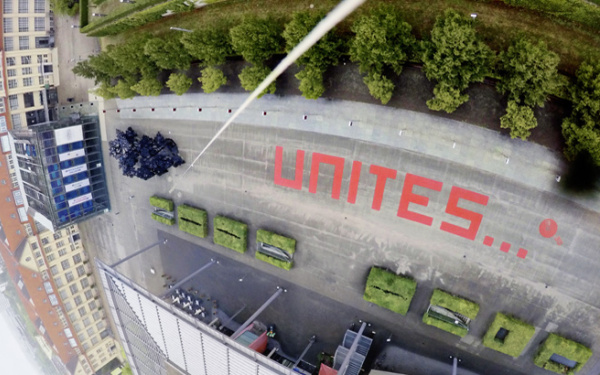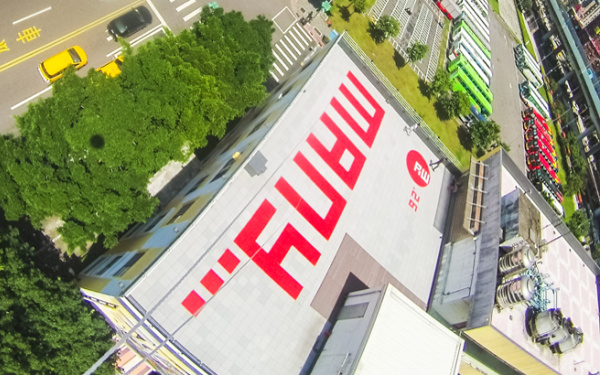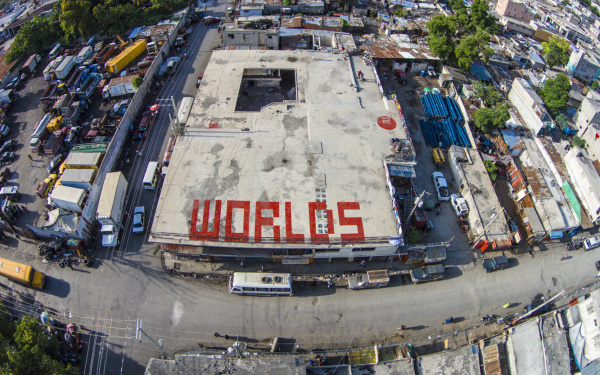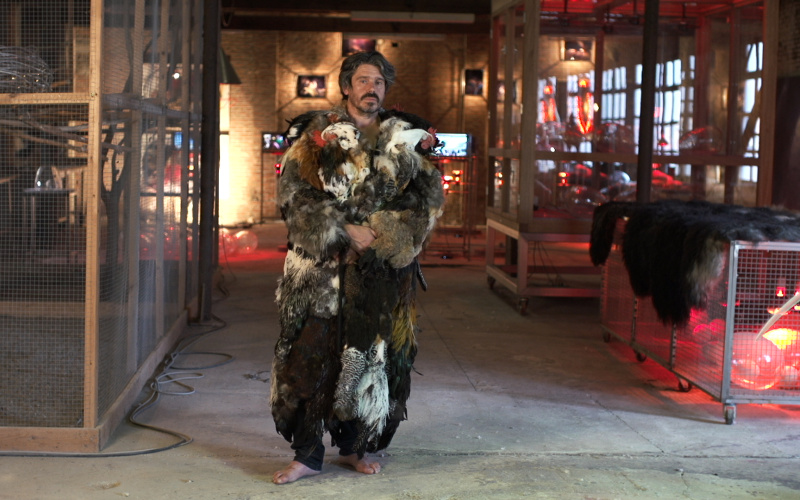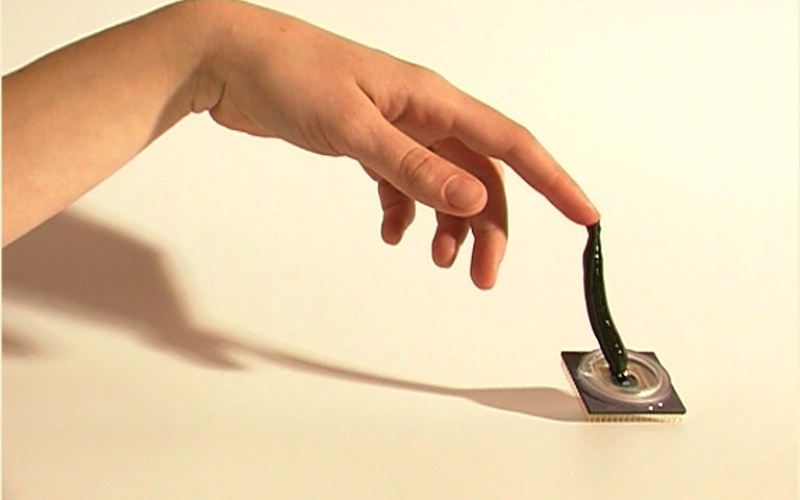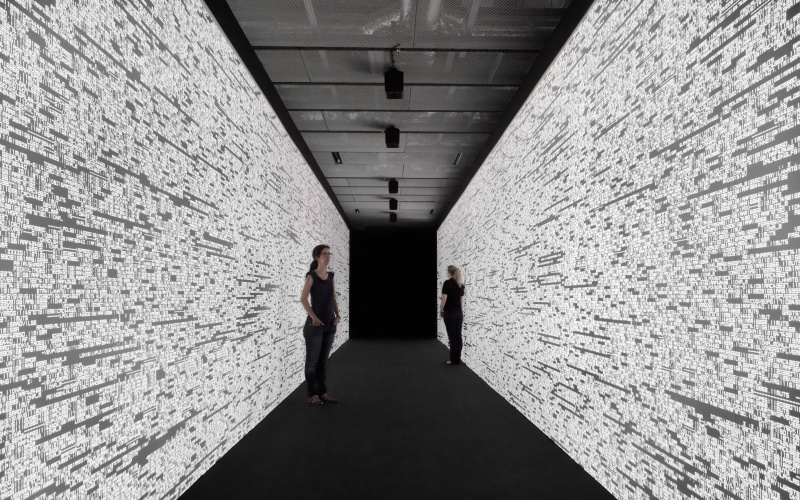The surface of the earth as a white canvas
Achim Mohné and Uta Kopp from REMOTEWORDS about their project for GLOBALE
AN INTERVIE WITH ACHIM MOHNÉ
Writing is considered a basic prerequisite for the development of the »Infosphere«: it makes storage and coding, among other things possible. Everything also revolves around the written form of the word with the long-term project REMOTEWORDS from Achim Mohné and Uta Kopp.
As part of the »Infosphere« exhibition they have installed five words on five continents or in front of five cultural institutions which reveal a sentence from Peter Weibel: The special feature here: the large-scale letters are only recognisable as a word from the bird’s eye perspective – »Google Earth« or »Bing Maps« are therefore suitable tools in order to make this project visible.
In the interview, Achim Mohné tells us which ideas are behind the project, how it can be realised and which importance is attached to the combination of word and location.
Stefanie Strigl: Since 2007 the art project REMOTEWORDS has conveyed messages on roofs which are only recognisable from the bird’s eye perspective. What is the idea behind this?
Achim Mohné: We understood the virtual globes which appeared for the first time in 2005 as »Google Earth« as a new medium that would be interesting to cast artistically. We saw a »possibility space« in the truest sense. The entire surface of the earth was there like a white canvas, an unexploited action area which had only just come into being through the new technology. Based on this, in 2007 we developed the concept for »REMOTEWORDS« as a subversive strategy of »analogue hacking«. In contrast to graphic artists, we operate in harmony with institutions, but not with the distributors who transport our message. Satellites observe us without being asked and we send our message back on the same channel.
Stefanie Strigl: Why must we first take up a distance in order to understand messages? You play with proximity and distance. How does this transfer to our globalised world? Can we only better understand our everyday events by thinking globally?
Achim Mohné: I think the attraction lies especially in the paradox of proximity and distance, i.e. that the visible messages are not occluded locally and can only be experienced by means of a medium, but the medium is globally comprehensible. In the tradition of »land art« we utilize the surface of the earth and process it nearly traditionally, not different from the draftsmen of the Nazca Lines thousands of years ago. However, we do not arrange these areas for a (potential) divine view, i.e. not in a natural sense, but with the goal of creating a new artefact that functions as an »orientation tool« in an extremely mobile era.
Stefanie Strigl: How is the selection of the location, building and the respective word or sentence placed there determined?
Achim Mohné: It is particularly important that the location and the words form a semantic unit. So the messages and locations are not arbitrary or interchangeable. This is the basis of the concept and is developed in consultation with the involved parties, us, the authors and institutions. For instance, »ASYL« (»ASYLUM«) – a message which works with the history of the location – is on the roof of a former border station near Aachen.
The selection of roofs for the GLOBALE is a special case, since the localisation on five continents was paramount. As it were, it was important to integrate different types of institutions and locations and thus to reflect Peter Weibel’s message. So we were able to contrast the ZKM as a renowned museum with the Ghetto Biennale in Haiti, which is situated in a rather chaotic urban context.
– Achim Mohné
»We are sending a message back on the same channel that observes us without being asked.«
Stefanie Strigl: Within the framework of the GLOBALE you have arranged five roofs on five continents with five words which reveal a sentence. How was the coordination of this project arranged? Which locations were selected and why? And which partners are involved?
Achim Mohné: Spreading words on several roofs came to us as an idea for the GLOBALE. Every word stands alone, but the entire semantic meaning of the sentence can only be learned by means of a virtual trip around the globe. This symbolises the phenomena of globalisation which appears as a constant interaction between local and global action.
Coordination was a challenge because the countries have very different laws and also mentalities – but logistical, practical and meteorological conditions were also important. In Africa, nobody was interested in safety on the roof, but sun and wind can really take a lot out of a person. In New Zealand, safety regulations can jeopardize the project or the unpredictable weather can delay completion.
In addition to the symbolic distribution on five continents, we also preferably wanted to find such locations which show the great differences in the living conditions on the Earth in order to consequently support the sentence’s statement.We selected Soweto for the beginning of the sentence. The former ghetto in South Africa became a symbolic location for an »unjust world« of power and oppression during the apartheid policy.
One earth unites many worlds
»ONE« also stands for an envisaged unified Africa. As a charitable and cultural institution, the Soweto Kliptown Youth Centre (SKY) is of immense importance for Kliptown and helps to diminish problems such as poverty, hunger, AIDS, drugs and violence.
For »EARTH« we selected New Zealand, a country that embodies the content defined by water – Oceania – like no other, reminding everyone that two-thirds of the Earth consists of oceans which are economically and ecologically irreplaceable. With the Manukau Institute of Technology (MIT) we selected an institution which strongly promotes New Zealand’s ethnic Maori culture.
»UNITES« was selected for the ZKM because it probably unites digital and electronic arts like hardly any other institutions and therefore also has a cross-cultural function. Germany with its reunification stands globally for a bridging of politically hostile systems.
»MANY« in Taipei is set in a state that is claimed by the most populous country in the world, while Taiwan sees itself as independent of China. Here again is also an open conflict about national borders and territories.
»WORLDS« in Porte-au-Prince in Haiti is installed in one of the poorest countries that was severely scarred by the most recent earthquake and strongly characterised by the history of slavery.
The individual stations and project partners:
- RW.26 at Taipei Artist Village, Taiwan, Asia
- RW.27 with Ghetto Biennale, Port-au-Prince, Haiti, America
- RW.28 at Soweto Kliptown Youth Centre, Johannesburg, South Africa, Africa (in cooperation with the Sylt Foundation)
- RW.29 at Manukau Institute of Technology, Faculty of Creative Arts in Auckland, New Zealand, Oceania
- RW.30 at ZKM | Centre for Art and Media, Karlsruhe, Germany, Europe
Technical facts about the REMOTEWORDS project
The colour is matched to the background of the roof and should have the highest possible contrast. Red is usually used, but also white and black. But the project’s recognisability is transported less through the colour, but rather through the pixel font and through the REMOTEWORDS logo that simultaneously serves as a counter.
The size of the letters and their placement on the roof depend on the building’s architecture. Consequently, the architecture also influences the choice of words. With smaller roofs this is particularly a challenge for the authors, who must be as brief as possible. The legibility, which depends on the respective resolution and text length, is better in cities than in the countryside, and usually much better in western countries than in the Third World.
The messages should be preserved as long as possible. That is why REMOTEWORDS uses high-quality materials which brave the weather. This should be about 20 years under normal circumstances. They should at least remain until update on one of the navigation systems. The longer they stand, the greater is the chance that they will emerge on one or more systems such as Apple Maps, Google Earth or the map service from Bing.
Category
News Category
- tracks & records
